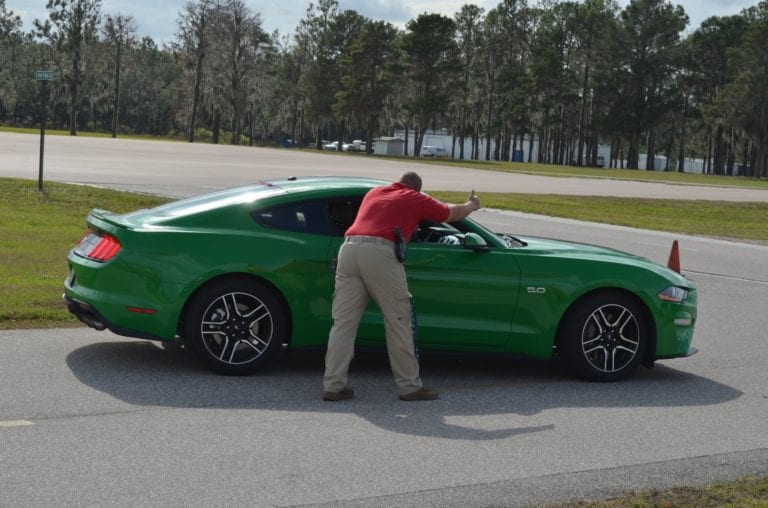
HCSO held a Teen Driver Challenge Saturday where experienced deputies taught 20 teens how to become expert drivers.
Hillsborough County Sheriff’s Office is taking steps to ensure local youth are prepared for anything they may come across while behind the wheel.
Deputies host a Teen Driver Challenge approximately four times a year. Last Saturday, 20 teens rolled up in

their personal cars to the Walter C. Heinrich Practical Training Site in Lithia to learn how to respond to issues like emergency braking, defensive driving and safely correcting the vehicle once drifting off-road.
The course is part of the Florida Sheriffs Association (FSA) and was created in 2007 to help teens deal with a variety of unavoidable factors.
“These skills are the things they won’t get at their driver's ed,” Deputy Jeff Ramer said. “These are kids that have been driving for a while, maybe they’ve got a year or two under their belt. Now we’re adding advanced driving skills to their skill set. This challenge really encompasses the things the kids may see if they come into a sticky situation on the road.”
The program is free for teen drivers in 38 counties across Florida and taught by sheriffs’ deputies that are licensed as commercial driving school instructors. These are the deputies that train officers for the local departments and they have hundreds of hours clocked behind the wheel. According to the FSA, more than 2,000 students participate in a TDC course each year, with “the demand for course participation often outweighing availability.”
Ramer said one major benefit of the course is the students are driving their own cars, not standard vehicles from driver's ed. They are learning exactly how their personal vehicles respond in different situations and thus walk away with a personalized encounter and a real understanding of exactly what their cars can and cannot handle.
Ramer led the students through all of the classroom material covering everything from basic safety instructions to more intense discussions around DUIs and other common roadway crimes. Then he led them to a garage where they learned to give their car a check-up, tackling upkeep like monitoring the tire pressure, safety gauges and even how to check the oil.
Deputy Jimmy Cook and Master Deputy Clint Leapley take it from there, splitting the students up and beginning to run them through obstacles on the training pad. The teenagers drive their cars through tight figure eights, a serpentine driving maneuver, parallel parking, off-road recovery, emergency braking and more.

The young drivers are told today was the day to ask any questions they could think of, that nothing was “stupid” or “too naive.”
Cook said the one thing most students overestimate is their realistic reaction time. With the emergency breaking course, he gets in the vehicle with the student, telling them to bring their car up to a certain speed and not touch the brakes until he says stop. Then they have to quickly brake and steer the vehicle between one of two lanes of cones.
“I get into the car with them because I really want them to push themselves, to see what it’s like if they’re driving down the interstate or down the road and something goes wrong,” Cook said. “I think the most helpful skills today are a cross between the braking and the evasive maneuver. Those are the most important ones.”
While some of the challenges like the serpentine and figure eight test skill level, the other obstacles could be the difference in responding in time to save a life or not. All three instructors said the students weren’t very talkative, but slowly grew in confidence as the day progressed and they realized they did have the potential to successfully navigate the tough course.
“It’s a mix of a lack of experience and a lack of confidence in their skills,” Leapley said. “A lot of these drivers, this is their first year or two with their cars and they’re still learning what it can do.”
He said one student in his group was nearly shaking with nerves at the beginning. She was convinced she wasn’t going to be able to successfully complete the drills. Hours later she was laughing as she completed

another obstacle without more than simple guidance from Leapley.
Some students sign up because they genuinely desire to become better drivers while others are only there at their parent’s insistence. Regardless, they all walk away a more experienced driver than when they pulled into the facility. Some insurance companies also offer lower rates when the driver presents the certificate they receive for completing the course.
Florida regularly is ranked as having some of the worst drivers in the nation and teens face some of the highest injury and fatality rates.
In 2016, 2,433 teens in the U.S. from age 16 to 19 years old were killed and 292,742 were treated in hospitals for injuries from vehicle crashes, according to the Centers for Disease Control and Prevention. The group also found while teens were only 6.5% of the population they accounted for approximately $13.6 billion or 8.4% of the total costs of motor vehicle injuries.
Across Florida, sheriffs departments are coming together to attempt to tackle those daunting statistics. By teaching kids simple, but essential skills, they hope to decrease the number of accidents and fatalities caused by a mere lack of experience behind the wheel.
The plan is for HCSO to offer another program in the new year and Ramer said the classes have been filling up quickly. He encouraged anyone interested to follow HCSO’s social media and website to see when registration would open.
